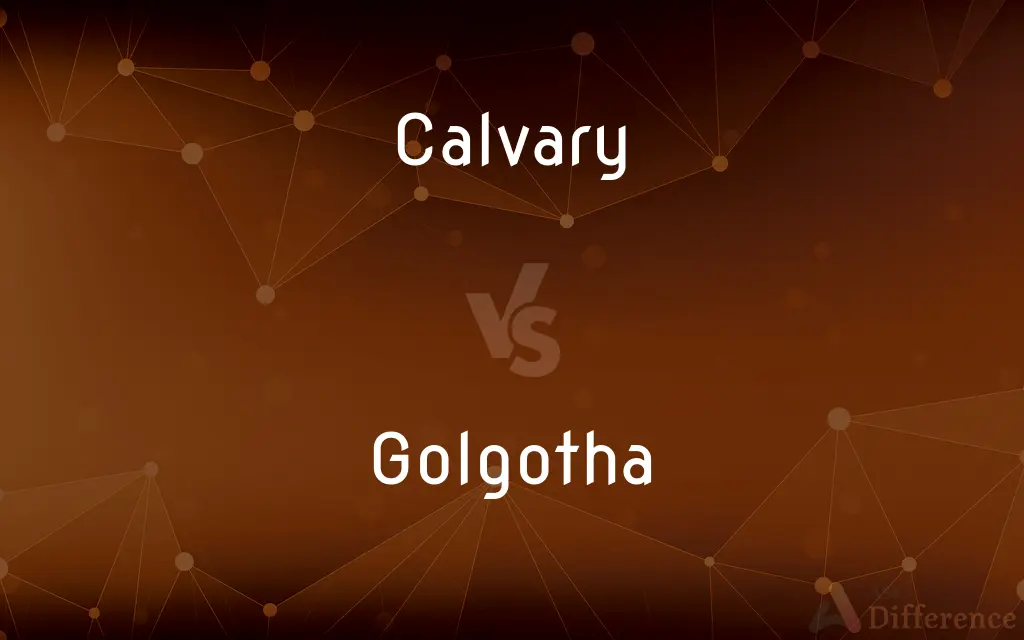Calvary vs. Golgotha — What's the Difference?
By Tayyaba Rehman — Updated on November 5, 2023
Calvary is the English name for the site of Jesus's crucifixion, Golgotha is the Aramaic name, both referring to the same location.

Difference Between Calvary and Golgotha
Table of Contents
ADVERTISEMENT
Key Differences
Calvary and Golgotha refer to the same geographical location but come from different linguistic origins. Calvary is derived from the Latin word 'Calvaria,' which means “skull,” while Golgotha comes from an Aramaic word that also means “skull.” Calvary is the term commonly used in English-speaking traditions when referring to the site of Jesus Christ's crucifixion.
Golgotha is the original name used in the Bible, specifically in the New Testament, and it conveys a more direct connection to the ancient texts for many readers. Calvary, being the Latinized form, is often used in the context of Christian worship and theology in Western traditions.
The use of Calvary in English has extended metaphorically to refer to an experience of intense suffering or a situation that tests one's endurance. Golgotha, however, typically retains its specific biblical context and does not commonly extend into metaphorical use.
In art and literature, Calvary is frequently represented symbolically as a hill or a rugged site, emphasizing the solemnity of Christ’s crucifixion. Golgotha, while it represents the same location, is often used to evoke a more historical or biblical scene, taking the reader or viewer directly to the events of the New Testament.
While both words refer to the site of the crucifixion, their usage differs in religious practice and cultural references, with Calvary being more prevalent in English-speaking Christian contexts and Golgotha being used for historical or ecumenical emphasis.
ADVERTISEMENT
Comparison Chart
Language Origin
Latin
Aramaic
Common Usage
In English, especially in Christian texts
In scholarly and historical contexts
Metaphorical Use
Yes, as a symbol of suffering
Rarely, mostly remains specific to its biblical context
Depiction in Art
Often stylized as a hill or cross
Depicted as a biblical, historical place
Literary Context
Used in broader literature and hymnology
Used mainly in translations of the Bible
Compare with Definitions
Calvary
A place of ordeal or sacrifice
The marathon was his Calvary.
Golgotha
The Aramaic name for the place where Jesus was crucified
Golgotha is a site of pilgrimage.
Calvary
An experience that causes intense suffering
Her struggle with illness was a real Calvary.
Golgotha
The biblical term for Calvary
The Gospels say Jesus was brought to Golgotha.
Calvary
A cross, set upon three steps; - more properly called cross calvary.
Golgotha
A name meaning “the place of the skull”
Golgotha's name is thought to describe the hill's appearance.
Calvary
A sculptured representation of the Crucifixion
The church's altar was adorned with a Calvary.
Golgotha
A term used to evoke historical crucifixion scenes
Paintings of Golgotha often depict stark landscapes.
Calvary
Calvary, or Golgotha (Koinē Greek: Γολγοθᾶ[ς] Golgothâ[s], traditionally interpreted as reflecting Syriac: ܓܓܘܠܬܐ gāgūlṯā, as it were Hebrew gulgōleṯ "skull" (גולגולת); Arabic: جلجثة), was, according to the canonical Gospels, a site immediately outside Jerusalem's walls where Jesus was crucified.The Gospels use the Koine term Kraníon (Κρανίον) or Kraniou topos (Κρανίου τόπος) when testifying to the place outside Jerusalem where Jesus was crucified. E.g., Mark 15:22 (NRSV), "Then they brought Jesus to the place called Golgotha (which means: 'the place of a skull')." Kraníon is often translated as "Skull" in English, but more accurately means Cranium, the part of the skull enclosing the brain.
Golgotha
A site referenced for its biblical significance
Sermons on Good Friday recount the events at Golgotha.
Calvary
The hill outside Jerusalem on which Christ was crucified.
Golgotha
A place or occasion of great suffering.
Calvary
A sculptured depiction of the Crucifixion.
Golgotha
Calvary. See the Note under Calvary.
Calvary
Calvary A great ordeal.
Golgotha
A hill near Jerusalem where Jesus was crucified
Calvary
A life-size representation of the crucifixion of Jesus Christ on a piece of raised ground.
Calvary
A series of representations of Christ’s Passion in a church.
Calvary
A type of monumental public Christian cross, sometimes encased in an open shrine.
Calvaries are typical of Galicia (Spain) and Portugal.
Calvary
A strenuous experience.
Calvary
The place where Christ was crucified, on a small hill outside of Jerusalem.
Calvary
A representation of the crucifixion, consisting of three crosses with the figures of Christ and the thieves, often as large as life, and sometimes surrounded by figures of other personages who were present at the crucifixion.
Calvary
A hill near Jerusalem where Jesus was crucified
Calvary
Any experience that causes intense suffering
Calvary
A monumental structure on the site of a crucifixion
Pilgrims visited the ancient Calvary.
Common Curiosities
Is Golgotha mentioned in the Old Testament?
No, it's mentioned in the New Testament.
Why is it called Calvary?
Calvary is the Latin form of the Aramaic word Golgotha.
Do all Christian denominations use Calvary?
Most do, but some may prefer Golgotha for its historical context.
Are Calvary and Golgotha the same?
Yes, they refer to the same historical place.
Is Golgotha a common name for churches?
It's less common than Calvary for church names.
Is Calvary used in a non-religious context?
Rarely, though its metaphorical sense can be secular.
What type of place was Golgotha?
It's believed to be a hill outside ancient Jerusalem.
Does Calvary appear in hymns?
Yes, especially in those about the crucifixion.
Can Calvary be used metaphorically?
Yes, to describe an experience of great suffering.
What does Golgotha symbolize in Christianity?
It symbolizes the site of Jesus’s crucifixion.
Is there a physical hill of Calvary today?
The exact location is a subject of debate.
Do pilgrims still visit Golgotha?
Yes, particularly in the Church of the Holy Sepulchre.
Why is it known as the place of the skull?
Possibly because of the site's shape or an association with death.
Has the site of Golgotha been archaeologically confirmed?
There are traditional sites, but its exact location is uncertain.
How is Golgotha depicted in art?
Often as a bare, skull-shaped hill.
Share Your Discovery

Previous Comparison
Byhearting vs. Recitation
Next Comparison
Entity vs. GestaltAuthor Spotlight
Written by
Tayyaba RehmanTayyaba Rehman is a distinguished writer, currently serving as a primary contributor to askdifference.com. As a researcher in semantics and etymology, Tayyaba's passion for the complexity of languages and their distinctions has found a perfect home on the platform. Tayyaba delves into the intricacies of language, distinguishing between commonly confused words and phrases, thereby providing clarity for readers worldwide.














































